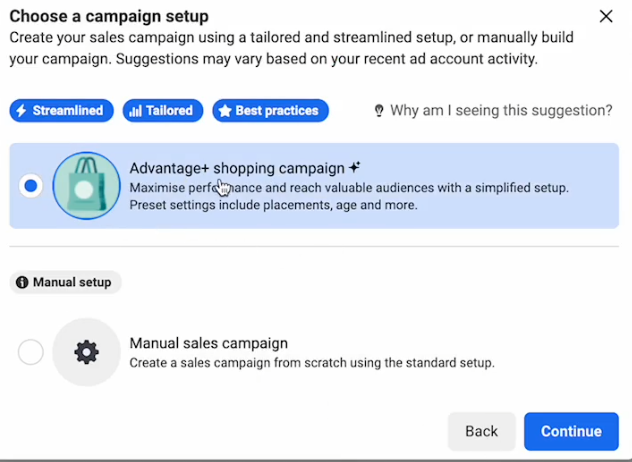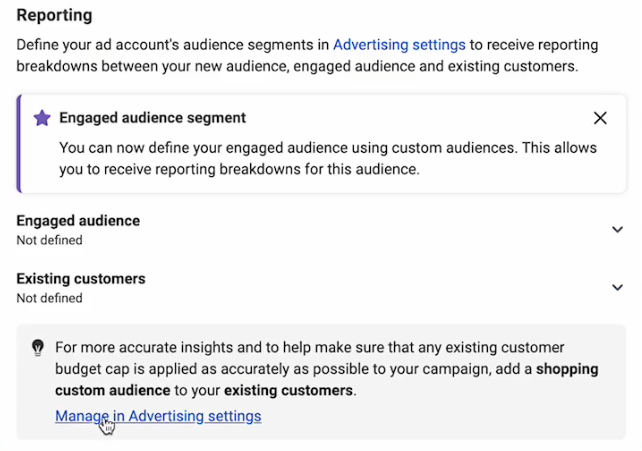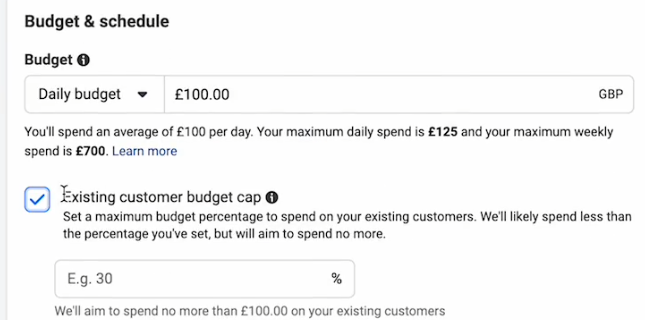Flash sales and promos can quickly boost your revenue by giving shoppers a reason to buy now. While your creative testing campaigns aim for fair comparisons and balanced spending, flash sales focus on efficiency and immediate returns. You want to push a strong offer across your entire funnel, from fresh prospects to loyal customers who already trust your brand. An Advantage+ Shopping Campaign (ASC) helps you do just that. It lets you combine your full audience pool, both new and existing customers, into one streamlined setup. With this structure, Facebook’s algorithm optimizes spending so you achieve faster, more profitable results.
This guide explains how to set up an Advantage+ Shopping Campaign for your flash sales and promos. It covers audience selection, budget allocation, offer presentation, and ad creation. By following these steps, you can quickly implement a promotion that reaches everyone in your funnel and capitalizes on urgency, strong discounts, and clear calls to action.
Why Use Advantage+ Shopping Campaigns for Flash Sales
Your creative testing campaigns stress controlled environments. They treat each ad variation fairly and isolate variables. In contrast, a flash sale’s priority is speed and efficiency. You do not need balanced testing right now. You need quick, broad exposure and a setup that reaches all relevant audiences without complex segmentation.
An Advantage+ Shopping Campaign merges your campaign and ad set levels. This structure limits your manual targeting options but gives more power to Facebook’s algorithm. For a flash sale, that’s beneficial. You want the algorithm to find conversions fast. You trust your strong discount or offer to attract people at every stage—top-of-funnel newcomers, mid-funnel warm leads, and bottom-of-funnel or existing customers. With the ASC, you set one main budget, define an existing customer pool, and let Facebook optimize. You focus on an irresistible offer, not on intricate targeting rules.
Setting Up the Campaign
Create a Sales Campaign:
In Ads Manager, click “Create” and choose the Sales objective. Instead of a manual sales campaign, select the Advantage+ Shopping Campaign option. This choice tells Facebook you want automated optimization and a streamlined campaign structure.

Name Your Campaign Clearly:
Use a clear naming convention. For example: “Flash Sale ASC” or “Promo ASC.” Also add something like “50% Off Offer” if that’s your discount. This naming practice helps you track performance easily.
Choose Website Conversions:
Ensure the campaign focuses on website conversions. Optimize for “purchase” events to let Facebook aim for real sales. You want to “maximize number of conversions,” which signals the system to prioritize people likely to buy.

Define Location and Settings:
Set your target location as usual (e.g., your main sales country). With flash sales, broad geographic targeting often works well, assuming you handle shipping or service logistics. Keep the rest of the targeting broad, since the algorithm will handle refinement.
Leveraging Existing Customers in ASC
One key advantage of Advantage+ Shopping Campaigns is the option to define an “existing customers” group. This group includes people who bought from you before or otherwise engaged deeply. Showing your flash sale to them first can yield quick, easy conversions, especially with a strong discount.
Access the Existing Customers Section:
Scroll down in your ASC setup until you find the “Existing Customers” setting. You will see a small light bulb icon and a prompt like “Manage in advertising settings.”

Add Your Retargeting Audiences Here:
Upload or select your custom audiences of past purchasers, engaged website visitors, or people on your customer email list. Include any high-intent retargeting segments. A flash sale with a big discount (e.g., 50% off) can re-activate these past buyers, encouraging them to return.

Define Budget Caps for Existing Customers:
After adding your existing customers, set a budget cap percentage. For example, if your daily campaign budget is $100 and you choose a 30% existing customer cap, $30 will focus on these known buyers. This ensures a good portion of your spend targets people likely to convert again quickly.

If you prefer more new customer acquisition, lower this percentage to maybe 20%. If you want to nurture your existing base heavily, go higher. Experiment with 20-30% initially for a balanced approach.
Full-Funnel Approach
Advantage+ Shopping Campaigns do not separate your audiences the way manual campaigns do. This is intentional. With a flash sale, your main selling point is the offer itself. Great discounts attract everyone. By mixing top-of-funnel and existing customers under one ASC, you let the algorithm seek out the best opportunities for sales in real time.
Your offer, say “50% Off Everything This Weekend,” hits all audience segments effectively. New prospects who were on the fence might now jump at the chance. Past customers who liked your product but waited for a sale now return and buy again. You do not need complicated, separate retargeting campaigns for this short promo period. One well-tuned ASC does the job.
Budget Considerations
When running a flash sale, you might allocate more daily budget than usual, since your goal is quick, intense exposure over a short time. Suppose you plan to run the promo for three days. You might triple your daily spend to maximize reach. Advantage+ Shopping Campaigns let you scale budgets easily.
If you spend $100/day normally, consider $300/day during the sale. Use the existing customer cap to ensure some spend hits loyal buyers. Let the rest flow to new audiences. The algorithm tries to find sales wherever possible.
Ad Creation and Offer Presentation
Your flash sale’s success often hinges on how clearly you present the offer. People must see the discount and understand what action to take.
- Multi-Advertiser Ads:
Turn this off. Multi-advertiser ads place multiple brands together in a feed unit. You want your promo front and center, not lost among competing offers. Disabling multi-advertiser ads ensures your message stands alone, grabbing attention. - Focus on the Offer in Primary Text and Headline:
Unlike creative testing campaigns where you try multiple angles, here you emphasize one main angle: the discount. For example, “50% Off All Products—This Weekend Only” or “Flash Sale: 30% Off Sitewide—Today Only.” These statements leave no doubt about what’s happening.Create two variations of primary text and headline. Variation one might say “50% Off All Items—Ends Sunday” and Variation two might say “Flash Sale: Grab Your Favorites at Half Price!” Both variations still highlight the offer, but the slight difference might catch different users. - Consistent Call to Action (CTA):
Use “Shop Now” as your CTA. It’s direct and fits the urgency of a flash sale. The user sees the sale, clicks “Shop Now,” and lands on your chosen product or collection page. - Landing Pages:
Decide whether to send them to a general collections page or directly to a best-selling product page. Collections pages let them browse all discounted items, which can be good if you have many products. A specific product page can work if your offer highlights a single hero product. For large promos, the all-collections page often works best. - Number of Ads:
With ASC, place four to seven ads in the campaign. If you have a large budget, lean towards more variations (up to seven). If your budget is moderate, four ads might suffice. These ads can vary slightly in images or text to maintain freshness. The algorithm will show whichever ad performs best.
Creative Suggestions
Your creative should scream “Sale!” Big, bold text stating the discount is effective. Use simple product images or lifestyle shots that show top products in an appealing context. Add a banner overlay that says “50% OFF” in large font.
If you have multiple products, consider a carousel ad showcasing a few top sellers all discounted. This gives viewers a taste of what’s on sale. If you have a hero product, feature it prominently with a big discount badge. Simple visuals often perform best during flash sales because users grasp the deal at a glance.
Testing Duration and Frequency
Flash sales are short, intense bursts of activity. Perhaps you run the sale for 48 or 72 hours. During this time, your ASC ramps up quickly, showing your ads to as many eligible people as possible. The algorithm leverages your existing customer cap to ensure some portion of spend goes to previous buyers. The rest tries to net new customers who jump on the discount.
Check performance after the first day. Are sales meeting your targets? If yes, keep going. If not, consider small tweaks: maybe raise your budget if you see a strong ROAS or cut spend if the sale is not resonating. The ASC structure is flexible. You can adjust spend day by day.
Conclusion
Flash sales and promos need agile, efficient campaign structures. Advantage+ Shopping Campaigns simplify the setup, letting you focus on one powerful offer that appeals to everyone. By adding an existing customer group, setting a budget cap, and presenting a clear discount message, you attract both new and old buyers with minimal fuss. The algorithm optimizes for sales, you earn a surge in revenue, and your brand leaves a strong impression during a short, high-impact promotional window.
Follow this guide and you’ll be ready to launch profitable flash sales or promos that cut through the noise, grab attention, and drive conversions fast